
129
This type of data transmission justifiable when large amounts of data are to be transmitted
but would be extremely expensive in real time monitoring since it occupies the channel all
of the time.
13.1.3. GPRS
„
General Packet Radio Services
” – a technology of transmitting data as addressed
digital packets. Seen from user's point of view it is identical to Internet technology. The
technology uses packet data protocols, particularly UDP/IP and TCP/IP.
This technology is radically different from technologies employed by standard modems
using GSM/CSD commuted mode.
The main difference is the inability to transmit the stream of data directly in traditional
serial protocols.
For transmission by GSM/GPRS modem it is necessary to "package" data in frames
compatible with employed protocol.
All procedures necessary for login to GPRS have to be completed, so connecting GSM/GPRS
modem to the data source operating in serial protocol ( MODBUS, PPI, SNP, M-Bus....)
incompatible with packet transmission specification is impossible - even if it has a serial
interface.
After completing login sequence we have a connection equal to virtual "wired connection"
available all of the time.
13.1.3.1. Advantages of GPRS technology
The absolutely greatest advantage of GPRS technology is the possibility for maintaining a
permanent connection with the network while paying only for the volume of transmitted
data with no charge for maintaining the connection. This makes establishing of "on line"
services for minimal expenses possible. An additional advantage is potentially high
transmission speed (up to ~170kb/s), facilitating high data volume transmission.
GPRS standard supports four channel encoding schemes named respectively CS1 to CS4
with throughput of
9,05 kb/s, 13,4 kb/s, 15,6 kb/s and 21,4 kb/s.
Reached this way, maximal transmission rates though rigidly defined are different
depending on the number of connected channels and limited usually to max throughput
of 115,2 kb/s (typically 8x13,4kb/s = 107,2 kb/s), and in particular situations even up to
171,2 kb/s (8x21,4=171,2).
13.1.3.2. GPRS in telemetry applications
GSM/GPRS technology is possibly the ideal solution for telemetry and control of dispersed
objects.
The undisputable advantages are:
•
Use of an existing advanced structure of GSM transmission structure.
•
The gigantic range of the network – works everywhere!
•
Low cost of establishing and utilizing the system
•
No need for specialized antenna systems
•
The possibility of building networked systems
•
No necessity for retransmission
•
Full access protection on operator and hardware level
•
Cost of transmission system maintenance rests with network operator
•
Easy rescaling and reconfiguration of the system
•
Great availability of various receiving terminals
•
Easy setup of temporary systems
•
Only transmitted data volume is charged
Содержание MT-101
Страница 1: ......
Страница 129: ...126 11 7 Drawings and dimensions ...
















































